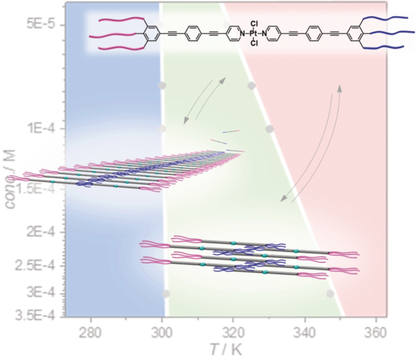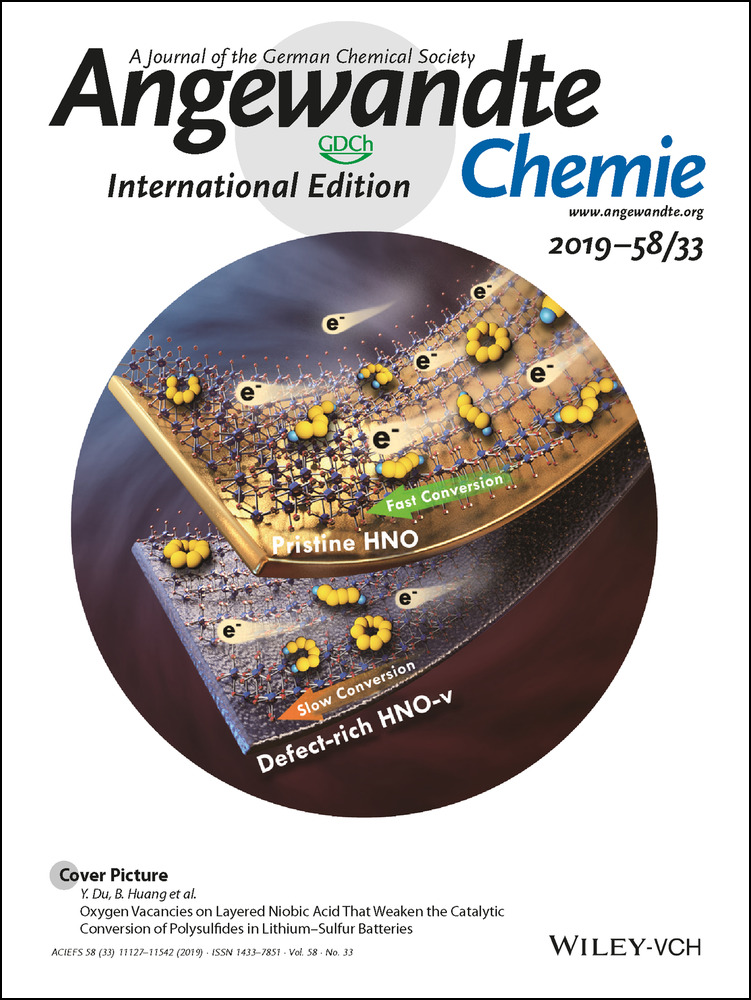Pathway Control in Cooperative vs. Anti-Cooperative Supramolecular Polymers
Lorena Herkert
Organisch-Chemisches Institut, Westfälische-Wilhelms Universität Münster, Corrensstraße 40, 48149 Münster, Germany
Search for more papers by this authorJörn Droste
Institut für Physikalische Chemie, Westfälische-Wilhelms Universität Münster, Corrensstraße 28/30, 48149 Münster, Germany
Search for more papers by this authorDr. Kalathil K. Kartha
Organisch-Chemisches Institut, Westfälische-Wilhelms Universität Münster, Corrensstraße 40, 48149 Münster, Germany
Search for more papers by this authorDr. Peter A. Korevaar
Institute for Molecules and Materials, Radboud University, Heyendaalseweg 135, 6525 AJ, Nijmegen, The Netherlands
Search for more papers by this authorProf. Dr. Tom F. A. de Greef
Institute for Molecules and Materials, Radboud University, Heyendaalseweg 135, 6525 AJ, Nijmegen, The Netherlands
Institute for Complex Molecular Systems, Department of Biomedical Engineering, Eindhoven University of Technology, The Netherlands
Search for more papers by this authorProf. Dr. Michael Ryan Hansen
Institut für Physikalische Chemie, Westfälische-Wilhelms Universität Münster, Corrensstraße 28/30, 48149 Münster, Germany
Search for more papers by this authorCorresponding Author
Prof. Dr. Gustavo Fernández
Organisch-Chemisches Institut, Westfälische-Wilhelms Universität Münster, Corrensstraße 40, 48149 Münster, Germany
Search for more papers by this authorLorena Herkert
Organisch-Chemisches Institut, Westfälische-Wilhelms Universität Münster, Corrensstraße 40, 48149 Münster, Germany
Search for more papers by this authorJörn Droste
Institut für Physikalische Chemie, Westfälische-Wilhelms Universität Münster, Corrensstraße 28/30, 48149 Münster, Germany
Search for more papers by this authorDr. Kalathil K. Kartha
Organisch-Chemisches Institut, Westfälische-Wilhelms Universität Münster, Corrensstraße 40, 48149 Münster, Germany
Search for more papers by this authorDr. Peter A. Korevaar
Institute for Molecules and Materials, Radboud University, Heyendaalseweg 135, 6525 AJ, Nijmegen, The Netherlands
Search for more papers by this authorProf. Dr. Tom F. A. de Greef
Institute for Molecules and Materials, Radboud University, Heyendaalseweg 135, 6525 AJ, Nijmegen, The Netherlands
Institute for Complex Molecular Systems, Department of Biomedical Engineering, Eindhoven University of Technology, The Netherlands
Search for more papers by this authorProf. Dr. Michael Ryan Hansen
Institut für Physikalische Chemie, Westfälische-Wilhelms Universität Münster, Corrensstraße 28/30, 48149 Münster, Germany
Search for more papers by this authorCorresponding Author
Prof. Dr. Gustavo Fernández
Organisch-Chemisches Institut, Westfälische-Wilhelms Universität Münster, Corrensstraße 40, 48149 Münster, Germany
Search for more papers by this authorGraphical Abstract
Abstract
Controlling the nanoscale morphology in assemblies of π-conjugated molecules is key to developing supramolecular functional materials. Here, we report an unsymmetrically substituted amphiphilic PtII complex 1 that shows unique self-assembly behavior in nonpolar media, providing two competing anti-cooperative and cooperative pathways with distinct molecular arrangement (long- vs. medium-slipped, respectively) and nanoscale morphology (discs vs. fibers, respectively). With a thermodynamic model, we unravel the competition between the anti-cooperative and cooperative pathways: buffering of monomers into small-sized, anti-cooperative species affects the formation of elongated assemblies, which might open up new strategies for pathway control in self-assembly. Our findings reveal that side-chain immiscibility is an efficient method to control anti-cooperative assemblies and pathway complexity in general.
Supporting Information
As a service to our authors and readers, this journal provides supporting information supplied by the authors. Such materials are peer reviewed and may be re-organized for online delivery, but are not copy-edited or typeset. Technical support issues arising from supporting information (other than missing files) should be addressed to the authors.
| Filename | Description |
|---|---|
| anie201905064-sup-0001-misc_information.pdf1.9 MB | Supplementary |
Please note: The publisher is not responsible for the content or functionality of any supporting information supplied by the authors. Any queries (other than missing content) should be directed to the corresponding author for the article.
References
- 1
- 1aP. A. Korevaar, T. F. A. de Greef, E. W. Meijer, Chem. Mater. 2014, 26, 576–586;
- 1bM. T. Dang, L. Hirsch, G. Wantz, J. D. Wuest, Chem. Rev. 2013, 113, 3734–3765;
- 1cS. S. Babu, S. Prasanthkumar, A. Ajayaghosh, Angew. Chem. Int. Ed. 2012, 51, 1766–1776; Angew. Chem. 2012, 124, 1800–1810.
- 2P. A. Korevaar, S. J. George, A. J. Markvoort, M. M. J. Smulders, P. A. J. Hilbers, A. P. H. J. Schenning, T. F. A. De Greef, E. W. Meijer, Nature 2012, 481, 492–496.
- 3
- 3aG. Ghosh, S. Ghosh, Chem. Commun. 2018, 54, 5720–5723;
- 3bJ. S. Valera, R. Gómez, L. Sánchez, Small 2018, 14, 1702437;
- 3cB. Kemper, L. Zengerling, D. Spitzer, R. Otter, T. Bauer, P. Besenius, J. Am. Chem. Soc. 2018, 140, 534–537;
- 3dM. Ogasawara, X. Lin, H. Kurata, H. Ouchi, M. Yamauchi, T. Ohba, T. Kajitani, T. Fukushima, M. Numata, R. Nogami, B. Adhikari, S. Yagai, Mater. Chem. Front. 2018, 2, 171–179;
- 3eM. F. J. Mabesoone, A. J. Markvoort, M. Banno, T. Yamaguchi, F. Helmich, Y. Naito, E. Yashima, A. R. A. Palmans, E. W. Meijer, J. Am. Chem. Soc. 2018, 140, 7810–7819;
- 3fK. Zhang, M. C.-L. Yeung, S. Y.-L. Leung, V. W.-W. Yam, Proc. Natl. Acad. Sci. USA 2017, 114, 11844–11849;
- 3gX. He, M.-S. Hsiao, C. E. Boott, R. L. Harniman, A. Nazemi, X. Li, M. A. Winnik, I. Manners, Nat. Mater. 2017, 16, 481–488;
- 3hM. E. Robinson, A. Nazemi, D. J. Lunn, D. W. Hayward, C. E. Boott, M.-S. Hsiao, R. L. Harniman, S. A. Davis, G. R. Whittell, R. M. Richardson, L. De Cola, I. Manners, ACS Nano 2017, 11, 9162–9175;
- 3iA. Sorrenti, J. Leira-Iglesias, A. J. Markvoort, T. F. A. de Greef, T. M. Hermans, Chem. Soc. Rev. 2017, 46, 5476–5490;
- 3jT. Fukui, S. Kawai, S. Fujinuma, Y. Matsushita, T. Yasuda, T. Sakurai, S. Seki, M. Takeuchi, K. Sugiyasu, Nat. Chem. 2017, 9, 493–499;
- 3kW. Wagner, M. Wehner, V. Stepanenko, S. Ogi, F. Würthner, Angew. Chem. Int. Ed. 2017, 56, 16008–16012; Angew. Chem. 2017, 129, 16224–16228;
- 3lA. Aliprandi, M. Mauro, L. De Cola, Nat. Chem. 2016, 8, 10–15;
- 3mF. Tantakitti, J. Boekhoven, X. Wang, R. V. Kazantsev, T. Yu, J. Li, E. Zhuang, R. Zandi, J. H. Ortony, C. J. Newcomb, L. C. Palmer, G. S. Shekhawat, M. Olvera de la Cruz, G. C. Schatz, S. I. Stupp, Nat. Mater. 2016, 15, 469–476;
- 3nJ. Kang, D. Miyajima, T. Mori, Y. Inoue, Y. Itoh, T. Aida, Science 2015, 347, 646–651;
- 3oR. D. Mukhopadhyay, A. Ajayaghosh, Science 2015, 349, 241–242;
- 3pS. Ogi, K. Sugiyasu, S. Manna, S. Samitsu, M. Takeuchi, Nat. Chem. 2014, 6, 188–195.
- 4T. F. A. De Greef, M. M. J. Smulders, M. Wolffs, A. P. H. J. Schenning, R. P. Sijbesma, E. W. Meijer, Chem. Rev. 2009, 109, 5687–5754.
- 5
- 5aH. M. M. ten Eikelder, A. J. Markvoort, T. F. A. de Greef, P. A. J. Hilbers, J. Phys. Chem. B 2012, 116, 5291–5301;
- 5bA. J. Markvoort, H. M. M. ten Eikelder, P. A. J. Hilbers, T. F. A. de Greef, E. W. Meijer, Nat. Commun. 2011, 2, 509.
- 6
- 6aJ. Gershberg, F. Fennel, T. H. Rehm, S. Lochbrunner, F. Würthner, Chem. Sci. 2016, 7, 1729–1737;
- 6bR. van der Weegen, P. A. Korevaar, P. Voudouris, I. K. Voets, T. F. A. de Greef, J. A. J. M. Vekemans, E. W. Meijer, Chem. Commun. 2013, 49, 5532–5534;
- 6cA. Arnaud, J. Belleney, F. Boué, L. Bouteiller, G. Carrot, V. Wintgens, Angew. Chem. Int. Ed. 2004, 43, 1718–1721; Angew. Chem. 2004, 116, 1750–1753.
- 7
- 7aR. Appel, J. Fuchs, S. M. Tyrrell, P. A. Korevaar, M. C. A. Stuart, I. K. Voets, M. Schönhoff, P. Besenius, Chem. Eur. J. 2015, 21, 19257–19264;
- 7bF. Fennel, S. Wolter, Z. Xie, P.-A. Plötz, O. Kühn, F. Würthner, S. Lochbrunner, J. Am. Chem. Soc. 2013, 135, 18722–18725;
- 7cH. Dong, S. E. Paramonov, L. Aulisa, E. L. Bakota, J. D. Hartgerink, J. Am. Chem. Soc. 2007, 129, 12468–12472;
- 7dW. S. Horne, C. D. Stout, M. R. Ghadiri, J. Am. Chem. Soc. 2003, 125, 9372–9376;
- 7eD. Zhao, J. S. Moore, J. Org. Chem. 2002, 67, 3548–3554;
- 7fE. R. Zubarev, M. U. Pralle, L. Li, S. I. Stupp, Science 1999, 283, 523–526.
- 8K. Cai, J. Xie, D. Zhang, W. Shi, Q. Yan, D. Zhao, J. Am. Chem. Soc. 2018, 140, 5764–5773.
- 9for reviews on assemblies of amphiphilic π-systems, see:
- 9aE. Krieg, M. M. C. Bastings, P. Besenius, B. Rybtchinski, Chem. Rev. 2016, 116, 2414–2477;
- 9bM. R. Molla, S. Ghosh, Phys. Chem. Chem. Phys. 2014, 16, 26672–26683;
- 9cW. Li, Y. Kim, J. Li, M. Lee, Soft Matter 2014, 10, 5231–5242.
- 10M. Kasha, Radiat. Res. 1963, 20, 55–70.
- 11
- 11aC. Rest, M. J. Mayoral, K. Fucke, J. Schellheimer, V. Stepanenko, G. Fernández, Angew. Chem. Int. Ed. 2014, 53, 700–705; Angew. Chem. 2014, 126, 716–722;
- 11bN. K. Allampally, M. J. Mayoral, S. Chansai, M. C. Lagunas, C. Hardacre, V. Stepanenko, R. Q. Albuquerque, G. Fernández, Chem. Eur. J. 2016, 22, 7810–7816;
- 11cC. Rest, A. Martin, V. Stepanenko, N. K. Allampally, D. Schmidt, G. Fernández, Chem. Commun. 2014, 50, 13366–13369.
- 12K. K. Kartha, N. K. Allampally, A. T. Politi, D. D. Prabhu, H. Ouchi, R. Q. Albuquerque, S. Yagai, G. Fernández, Chem. Sci. 2019, 10, 752–760.





